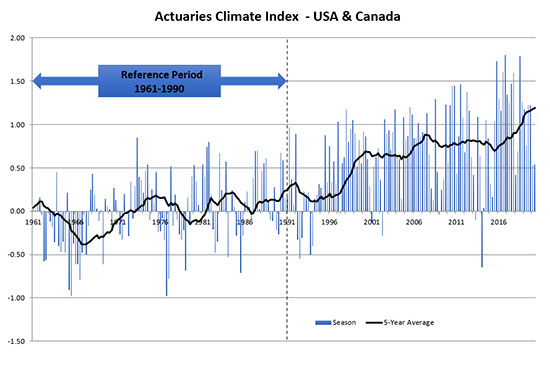Spring 2020 Data Update to the Actuaries Climate Index
As attention to climate issues grows, ACI provides objective data on key climate measurements
Washington, D.C., Arlington, VA, Schaumburg, IL, and Ottawa, ON (Dec. 1, 2020)—With climate risk issues receiving increased focus in 2020 and poised for even greater attention from the public and public policymakers in 2021, the Actuaries Climate Index continues to provide important up-to-date data for discussions on climate policy.
“The Actuaries Climate Index’s presentation of changes in key climate conditions across the United States and Canada is transparent, objective, and scientifically grounded—an ideal source for those engaging in discussions about climate-related policies,” says Doug Collins, chair of the Climate Index Working Group.
The key metric in the Actuaries Climate Index of a seasonal five-year moving average presents a composite measure of long-term changes across an array of observed weather extremes and sea levels in the two countries. It has steadily climbed from its most recent low of 0.70 in 2015 to a new high of 1.19 for the moving average in spring 2020. The measurements of extreme climate conditions tracked by the index—high and low temperatures, heavy rain, drought, high wind, and sea level—continue to move away from zero, which was the baseline for the index reference period of 1961 to 1990. The spring 2020 data release incorporates newly available sea level data for Canada for 2019.

The Actuaries Climate Index is based on an analysis of seasonal data from neutral, scientific sources for six index components collected since 1961. The index measures changes in these components for the United States and Canada combined and by region. Combining six components over a five-year measurement period, the index’s moving average smooths out monthly and seasonal fluctuations for a meaningful measurement of long-term climate trends.
The index—sponsored by the American Academy of Actuaries, the Canadian Institute of Actuaries, the Casualty Actuarial Society, and the Society of Actuaries—is designed to provide actuaries, public policymakers, and the general public with objective data about changes in the frequency of extreme climate conditions over recent decades.
Updated values are posted quarterly on ActuariesClimateIndex.org as data for each meteorological season become available.
About the Sponsoring Organizations
The American Academy of Actuaries is a 19,500-member professional association whose mission is to serve the public and the U.S. actuarial profession. For more than 50 years, the Academy has assisted public policymakers on all levels by providing leadership, objective expertise, and actuarial advice on risk and financial security issues. The Academy also sets qualification, practice, and professionalism standards for actuaries in the United States.
The Canadian Institute of Actuaries (CIA) is the national, bilingual organization and voice of the actuarial profession in Canada. Our more than 6,000 members are dedicated to providing actuarial services and advice of the highest quality. The Institute holds the duty of the profession to the public above the needs of the profession and its members.
The Casualty Actuarial Society (CAS) is a leading international organization for credentialing and professional education. Founded in 1914, the CAS is the world’s only actuarial organization focused exclusively on property and casualty risks and serves over 9,000 members worldwide. Professionals educated by the CAS empower business and government to make well-informed strategic, financial and operational decisions.
With roots dating back to 1889, the Society of Actuaries (SOA) is the world’s largest actuarial professional organization with more than 31,000 actuaries as members. Through research and education, the SOA’s mission is to advance actuarial knowledge and to enhance the ability of actuaries to provide expert advice and relevant solutions for financial, business and societal challenges. The SOA’s vision is for actuaries to be the leading professionals in the measurement and management of risk.
